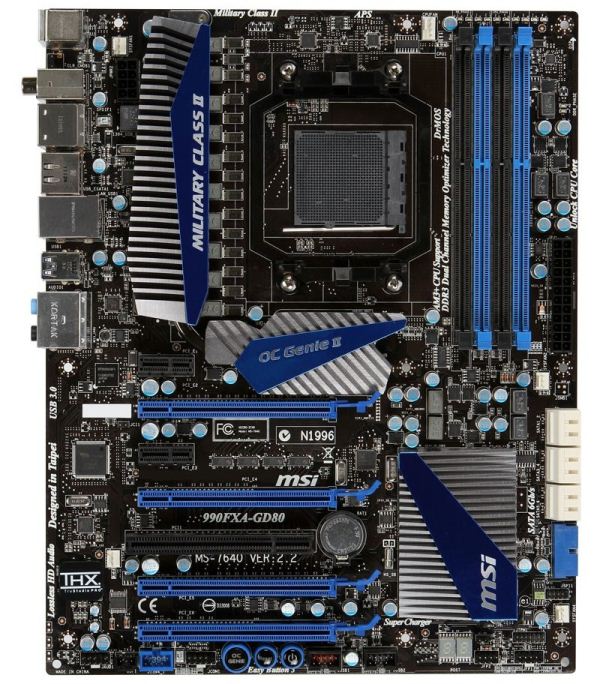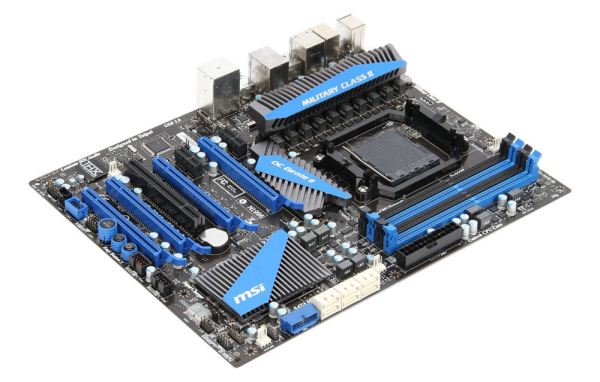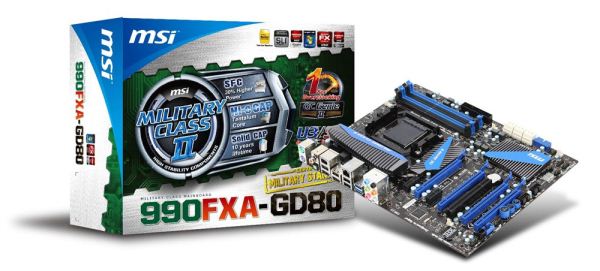990FX Motherboard Roundup with Thuban and Bulldozer – A Second Wind for ASUS, Gigabyte, MSI and Biostar
by Ian Cutress on April 5, 2012 11:00 AM ESTMSI 990FXA-GD80
Where the ASUS channel boards are called the LE, the standard, the Pro, and the Deluxe, Gigabyte has the UD3, UD4/H, UD5, UD7, UD9, and ASRock has Extreme3, Extreme4, Extreme6, Extreme7 and Extreme9. For MSI, this rears itself as a set of numbers preceded by the letters G or GD: we have the 80, 65, 55, 45, and 43, amongst others.
Channel boards are very important to all these manufacturers – they represent the bulk of consumer level sales whereas the gaming / overclocking / stability products are purely for niche environments. In most cases, the home user will only need a channel board, either at the high, medium or low end depending on need. So here we have the MSI 990FXA-GD80, which represents MSI’s higher end ‘mainstream’ offering.
The board itself currently e-tails for $195, slightly more than the ASUS Sabertooth 990FX and the Gigabyte 990FXA-UD5 in this combination review, but should offer a good comparison point. As it is up to $15 more than the Gigabyte, I hope that we can pin down where the $15 goes.
Overview
As a manufacturer, MSI has come up with some good products in their time (e.g. X79 Big Bang XPower II), and some that made me turn around and wonder ‘why?’ (e.g. the BIOS on the P67A-GD65). With our first look at some MSI AMD action in a fair while, I can say that while the 990FXA-GD80 is a nice board to work with, it is perhaps not the feature packed product to cover certain market areas. Do not get me wrong, MSI has some strong areas such as what comes In The Box with the board, however certain features like their fan header placement are not exactly optimal.
Performance wise, the MSI 990FXA-GD80 is no slouch, roughing it toe-to-toe with the other products we have in this review. Features such as the OC Genie, Power/Reset Buttons and a USB 3.0 header at right angles to the board are to be well received. The heatsink design and shape fits in well with the products image (despite the Military Class II paraphernalia obligatorily pasted across it), and the onboard PCIe layout has some thought behind it.
Users will note that different BIOS versions have different BIOS screens. If you update this beyond BIOS B5, the system will display the new graphical BIOS which MSI is very proud about (and it works rather well). However on startup, the board caused my AMD graphics cards (note, 5850s) to spin at 100% for several seconds. Somewhat odd behavior – the cards did not do this in other boards, and neither did our NVIDIA testing cards.
For overclocking, under Thuban the 990FXA-GD80 performed well giving respectable numbers. However while using the Bulldozer processor we were severely limited in terms of voltages and base frequency adjustments, limiting the range to which the overclocks can be performed. More on this is detailed in the Overclocking section.
This board, at $195, performs well for its money compared to other boards in its bracket, and with some bonuses in the box, would fit well into a 990FX system. With a few minor modifications/suggestions, this could have been the ultimate 990FX product, but nonetheless, I can see a lot of people using this board and enjoying it.
Visual Inspection
In keeping with MSI’s mainstream color scheme, the 990FXA-GD80 comes in with a distinct blue and black livery, sporting a very edge-heavy angular design on the heatsinks. The heatsinks, like on the previous three boards, provide a large amount of surface area and cover the VRMs to the left of the socket. This heatsink is connected via a heatpipe to another heatsink, in an effort to improve the cooling, and provide a little bit more advertising space on the board for features. The chipset heatsink is rather similar to that from the Gigabyte board, covering a large area of the board with fins but very low profile. It also all fits into the angular style.
In terms of the socket itself, despite the AM3 socket providing space, MSI has gone a bit further, giving more horizontal space than most other boards here and thus should not be an issue for large air coolers. For water coolers however the fan headers on board are neither that numerate (five in total) nor in ideal locations. The sole CPU header (4-pin) is next to the DIMMs in the top right of the socket, and the other socket fan header is above the 8-pin 12V header, but this is a 3-pin system header. Other fan headers on board are a 3-pin system fan header between the 24-pin ATX connector and the SATA ports, a 3-pin system fan header below the SATA ports (would be blocked by a GPU in the appropriate slot), and a three-pin system fan header to the left of the PCIe slots (would be blocked by an appropriate GPU). So if a user is running three large GPUs in this board, two fan headers instantly become inaccessible.
Down the right hand side of the board, below the 24-pin ATX power connector, are our SATA ports. MSI has decided to keep the standard set of six SATA 6 Gbps from the chipset, rather than add to it with controllers. However what MSI does do is give a USB 3.0 header at right angles to the board below the SATA ports. This suggests that this header is purely aimed at front panel USB 3.0 ports, either through the case or by a front panel addition.
The bottom of the board points to a couple of reasons as to why this board is $15 more expensive than the Gigabyte – we get power and reset buttons, as well as a two-digit debug LED. Also on board is the MSI standard OC-Genie button, offering a set overclock when pressed. Alongside these buttons are the standard array of USB 2.0 headers, front panel audio, a COM header, and an IEEE1394 header.
In terms of PCIe layout, MSI has done similar to Gigabyte with an x1 at the top, but this time the heatsink does not impede any long x1 cards. Below this we see a three GPU layout being emphasized, with full length PCIe slots being alternated such that we have: x1, x16, x1, x8, PCI, x8/16, x4.
The back panel is varied enough for this platform. We have two PS/2 ports, a Clear CMOS button, both optical and digital S/PDIF outputs, two eSATA ports, IEEE1394, four USB 3.0 ports, two USB 3.0 ports, Realtek 8111E gigabit Ethernet, and standard audio jacks. What MSI has done here is to try and include as many different protocols as possible, at the expense of USB 2.0 ports. Having four of them on the back panel of a board (and a pair of USB 3.0) covers most usage scenarios, and there are still a few front panel headers on board for more. It begs me to wonder if motherboard vendors should just use a single set of four USB 2.0 ports in one segment of the board, and then focus on all the other functionality. Some motherboard vendors do have that stack of four, but as with the Sabertooth and Gigabyte boards previously that have had 10 and 8 USB 2.0 respectively – are there usage models for this? If you personally use 8 back panel USB 2.0 ports (ignore front panel), then let me know in the comments – it will be interesting to see what is used.














57 Comments
View All Comments
IanCutress - Thursday, April 5, 2012 - link
Unfortunately we don't have an infinite amount of kit to review with. We're individual reviewers here, not all working in a big office. Obviously we can't all request top end kit from manufacturers either. Plus for every time we do use new high end kit, we also get comments about testing something 'more realistic' to most users. In that circumstance, we can't win and please everyone, but we do try and be as consistent as possible.Ian
phocean - Thursday, April 5, 2012 - link
I bought the Sabertooth a few weeks ago... and it throws an annoying buzzing sound in the speakers, especially when a USB port is used (in other words, all the time).It is the sign of an isolation issue between chipsets and shows poor design and testing from Asus.
Needless to say that the support was of no help (and no willing to help).
So don't buy it, unless you don't plug any speaker in it.
richaron - Friday, April 6, 2012 - link
Mine doesn't have this problem. You either got an unlucky board, or your psu is funky.extide - Thursday, April 5, 2012 - link
Seem to me like you were probably using a bit too much voltage for the BD. I would assume that is why you had so many issues with thermal runaway. 1.4-1.45ish would probably be a better place to stay with an air cooler :)extide - Thursday, April 5, 2012 - link
EDIT: Nevermind I forgot you are using the AMD kit watercooler, which is better than straight air cooling but I'd think it would take more of a fully custom built water setup to run 1.5v vCore.Hrel - Thursday, April 5, 2012 - link
I was going to build a new computer based on Ivy Bridge this Fall, I'm still running a Core 2 Duo E8400. But I've decided I'm not building myself a new computer until the motherboard has USB 3.0 and ONLY USB 3.0. A LOT of them, EVERYWHERE!I just built a guy a Z68 based computer with an i7 2700K but I had to order a VERY hard to find adapter card to plug in the USB 3.0 based memory card reader and the USB 3.0 on the front of the Fractal Design case. Because the Asus motherboard has ZERO USB 3.0 headers on it. It never even occurred to me that was a possibility. Not only has USB 3.0 been out for years now, but it was released WAY over-due. WTF is the hold up. Make the switch. USB 2.0 is for the 2000's decade, it's 2012. I am done with USB 2.0. I shouldn't have to buy an add-in card for BRAND NEW motherboard to support basic accesories, like a memory card reader and front usb port.
This is related to this article because I think if AMD was actually competitive with Intel AT ALL, like they were with Athlon XP/64/64 X2, then Intel would step up their game all around. Or maybe I wouldn't even have to buy Intel because they constantly make shit decisions like this, and changing the motherboard socket constantly, and charging 300 dollars for a quad core with HT. Their shit is endless and I really don't want to buy their products but AMD is simply not an option; if I wanted something that slow I'd just put a quad core Penryn based CPU in my current rig and save a bunch of money.
ggathagan - Friday, April 6, 2012 - link
There are only two Asus Z68 boards that don't have the USB 3 header, but somehow it's *Intel's* fault that Asus didn't use a USB 3 header on the board you bought?Huh...
Maybe you should have been a little more attentive when board shopping.
IanCutress - Friday, April 6, 2012 - link
Hi Hrel,I actually like USB 2.0 on my boards. If you have solely USB 3.0 and use them all, there's a big chance of a bottleneck in the bus somewhere. Also, I install a fresh operating system on every board I test via USB as it is a lot quicker than CD. Unfortunately during the install program, it doesn't process anything through the USB 3.0 ports - mouse, keyboard, or even the USB stick with the OS on. So I ideally like to have three USB 2.0 ports for that purpose. It's more a fault of Windows7 than the chipset, but otherwise if a board only has two USB 2.0 ports, I have to disconnect the mouse and use the keyboard and USB install drive only. Saying that, I have a board in that is solely USB 3.0, so it's going to be fun to install an OS on that... :/
Ian
fic2 - Friday, April 6, 2012 - link
I have a Dell keyboard that has 2 USB ports on it. That would solve your problem with a 2 x USB 2 mb. I currently have the mouse daisy chained off the keyboard.B - Thursday, April 5, 2012 - link
Your article should note that sound blaster provides a software overlay, but under that aluminum skin overlay lies a Realtek chip. I was fooled by this marketing and very disappointed after configuring this motherboard and discovering this fact. You don't get soudblasters hardware acceleration or the crystalizer. You should note this in any article about the asus line with x-fi2. Had I known I would have done things differently.